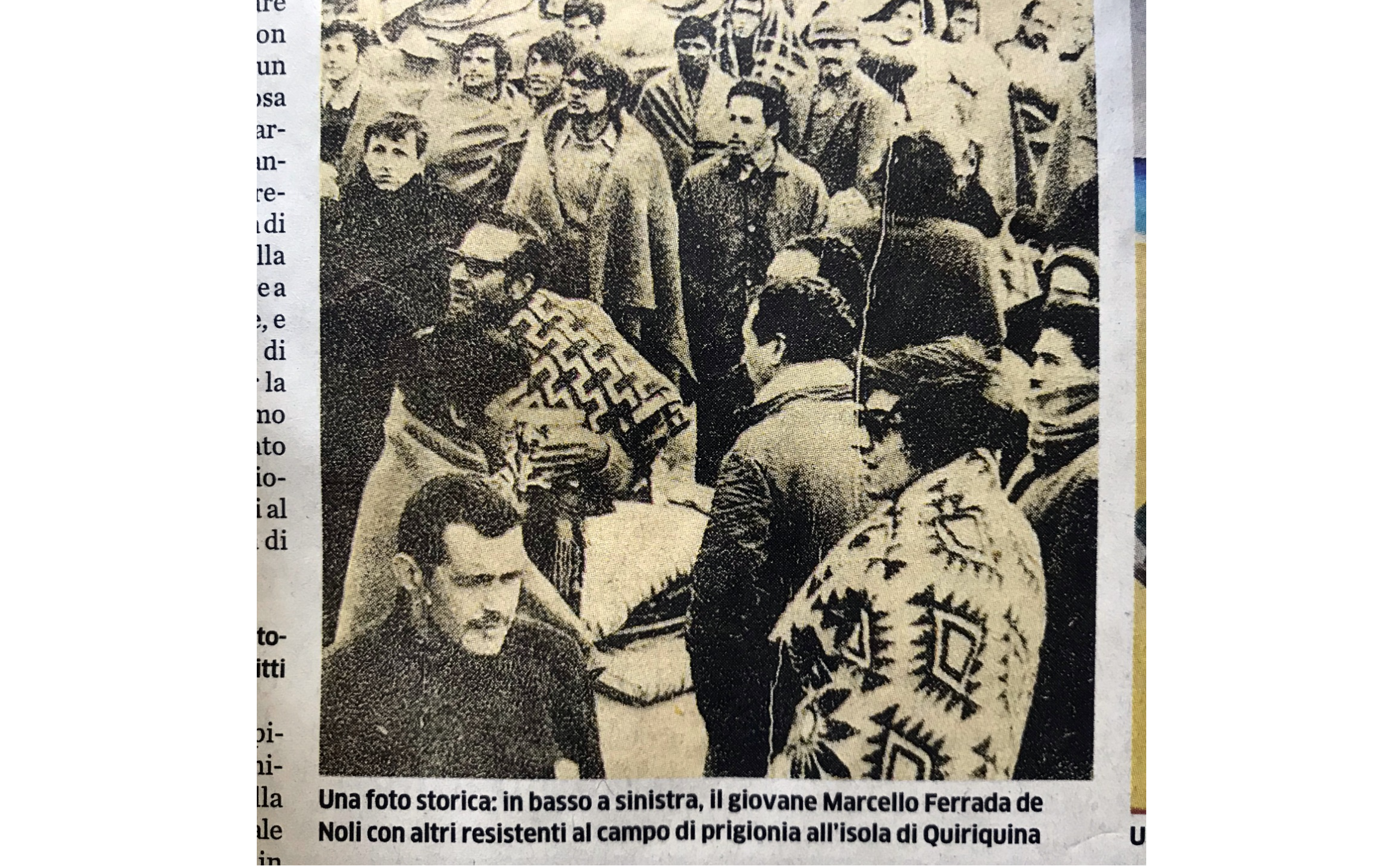Image above published by Italian newspaper L’Eco di Bergamo. Translated caption: “An historical photo. A young Marcello Ferrada de Noli together with other Resistance members at the prisoner’s camp of Quiriquina Island”.
Professor Med Dr Anders Romelsjö: “It’s high time to spread this unique report by my friend and colleague, Professor Emeritus Marcello Ferrada de Noli, who –as well as myself– was working at the Department of Public Health Science at The Karolinska Institutet, the Sweden’s medical university. He is the founder and chairman of SWEDHR, Swedish Doctors for Human Rights, where I am Vice President. He is also the founder and chief editor of The Indicter.
Now, one month has passed since the 11th anniversary of the US-supported Chilean military coup led by General Pinochet in 1973. But Ferrada de Noli’s testimony (originally published in the Lotta Continua series “Ferrada de Noli VS. Pinochet“, and (2008, 2013) in “September 11th, 1973“, it is as relevant today as it has been during the well over 500 months that has passed since the US-supported coup of 1973 in Chile.
At that time I was a a rather novice new-appointed district physician at Krylbo, in Avesta, Sweden. There, during my free time, every week, I stood and sold socialist newspapers. Of course Pinochet’s coup of September 11, 1973, draw the attention to our public, as I vividly remember it.
The article by Professor Marcello Ferrada de Noli is very interesting in several ways. It shows, among other things, how a well-prepared socialist organization easily may suffer very hard in front of such military contingencies.
Editor’s Note: This is a translation of “Ett personligt minne från kuppen 11 september i Chile – av en revolutionär professor“, authored by Anders Romelsjö and published in Jinge.se 12 October 2018. /Dr Lena Oske MD, Acting Editor at The Indicter Magazine.
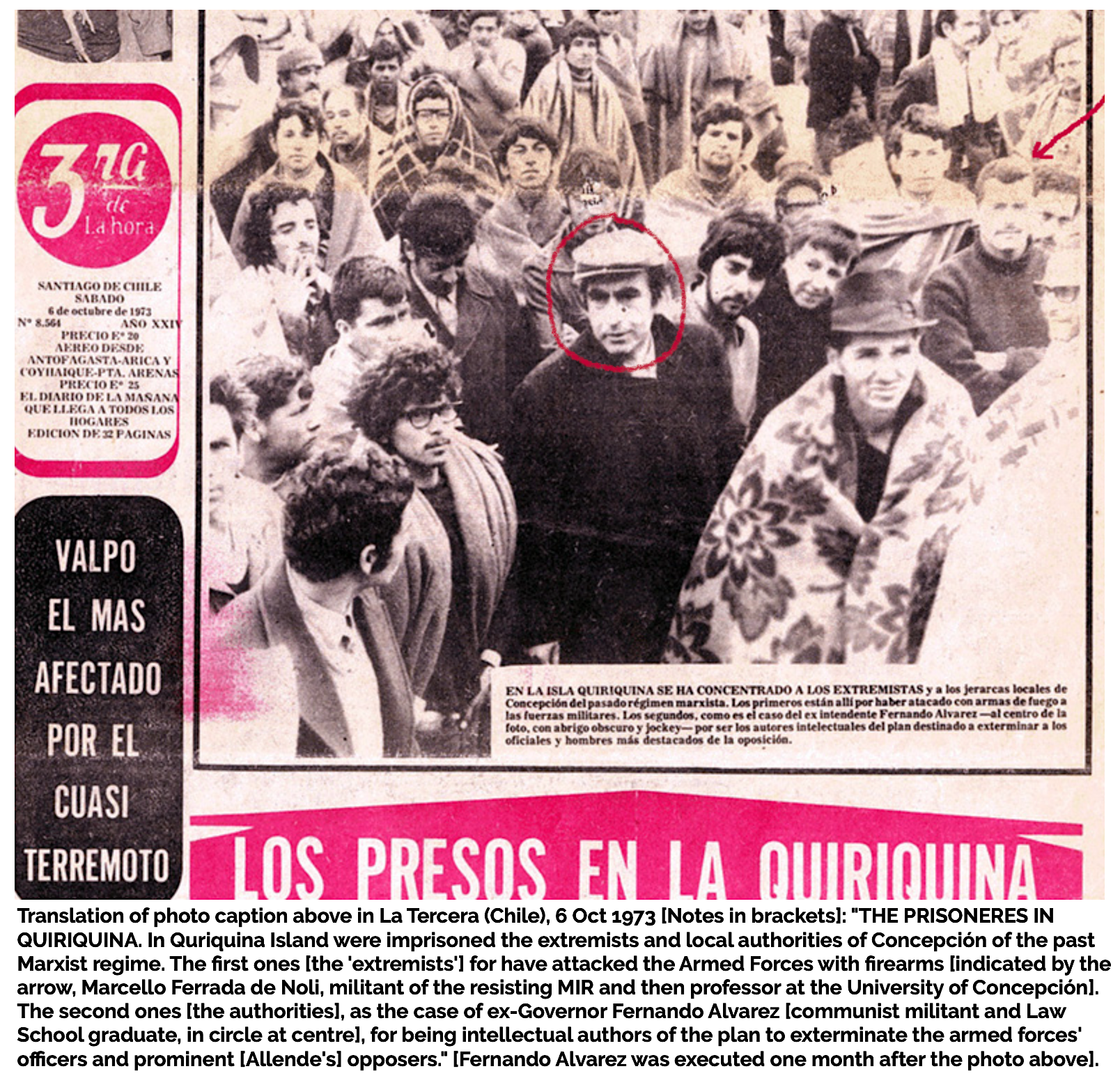
PART I. That morning of September 11, 1973. A personal testimony
By Prof Marcello Ferrada de Noli
Introduction
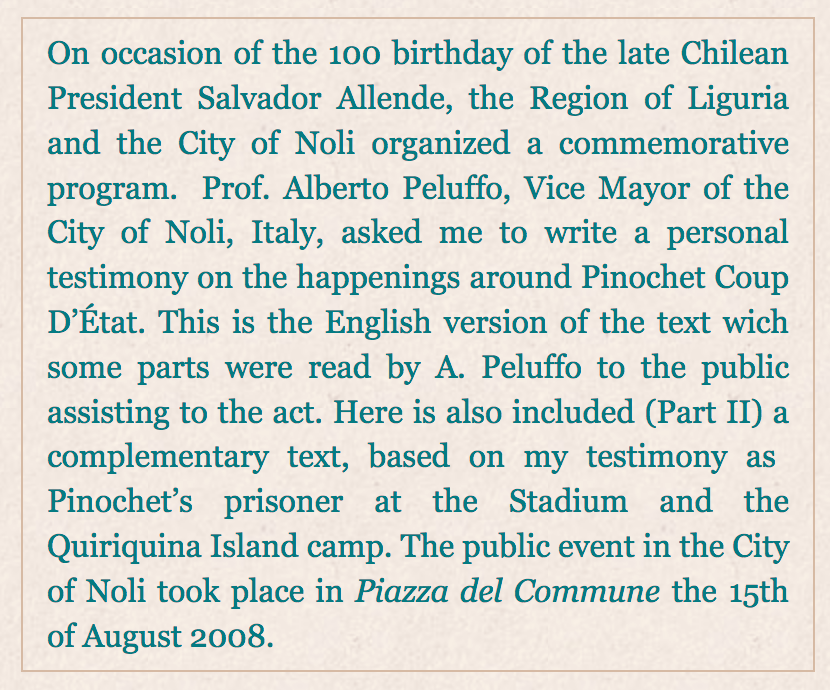 Combatants of the leftist organization MIR and from other leftist parties offered active resistance to Pinochet’s army on the 11th of September. However, the resistance to the military takeover was in general sporadic, with low firepower, and did not prevail. In other words it did not occur in the scale expected, or planned. We in MIR were some how psychologically prepared “for the moment to come” and for relevant activities, as we new (and even provided Allende with intelligence on the coup preparation) that the putsch was imminent. But the open direct resistance was crushed very soon, and also due to the brutality of Pinochet forces the core-militants did not succeed to encourage the mobilization of the vast majority of Allende supporters in order to take up the fight together. A third aspect was that Allende himself warned (on the 11 of September) the supporters that have elected him of not taking unnecessary sacrifices. I was in Concepción at the moment of the coup and at that time with assignment in the Organization detail of the Regional Committee, meaning that my “structure” was of a “central” kind. Three of the five members of the detail were captured. I spent times at different detention centres such as the Stadium, the Navy’s camp of prisoners at Quiriquina Island, the “marines” detention quarters at the Navy base in Talcahuano, and finally back to the Stadium in Concepción.
Combatants of the leftist organization MIR and from other leftist parties offered active resistance to Pinochet’s army on the 11th of September. However, the resistance to the military takeover was in general sporadic, with low firepower, and did not prevail. In other words it did not occur in the scale expected, or planned. We in MIR were some how psychologically prepared “for the moment to come” and for relevant activities, as we new (and even provided Allende with intelligence on the coup preparation) that the putsch was imminent. But the open direct resistance was crushed very soon, and also due to the brutality of Pinochet forces the core-militants did not succeed to encourage the mobilization of the vast majority of Allende supporters in order to take up the fight together. A third aspect was that Allende himself warned (on the 11 of September) the supporters that have elected him of not taking unnecessary sacrifices. I was in Concepción at the moment of the coup and at that time with assignment in the Organization detail of the Regional Committee, meaning that my “structure” was of a “central” kind. Three of the five members of the detail were captured. I spent times at different detention centres such as the Stadium, the Navy’s camp of prisoners at Quiriquina Island, the “marines” detention quarters at the Navy base in Talcahuano, and finally back to the Stadium in Concepción.
Many died in these places either under torture or executed by firing squad. For instance, in the photo here below taken at the prisoner camp of Quiriquina Island and published in the front page of the mayor Chilean newspaper “Tercera de La Hora” (6 of October 1973), is mentioned the Intendente of Concepción Fernando Alvarez (head for the Regional government at the moment of the coup), at the centre of the picture. In fact, he died under torture one month after that picture was taken. I am also depicted in the same photo, up right (signaled by the red arrow). The photo was taken at a visit of the Red Cross International at the camp, and for which I was to be thereafter considered as a “recognized” prisoner instead of risking “hidden” status.
Three factors have contributed to obscure the real magnitude of the resistance on the 11th of September and the days ensued. One is the reluctance of the putsch leaders of acknowledging the true magnitude of their casualties. Doing this would have shown that the resistance was effective and thus motivating its continuation. A second factor is that the far most of the operations were of clandestine character. Also, due to the fact that all the press, all TV channels and all radio stations were seized the 11th and remained under the direct control of the military (not only by decree, but physically under control) it was not possible either to communicate eventual results of the actions. A third is the “factor seguridad” of the militants and units involved. As cadres become arrested in increasing numbers, the units or combatants acting with own initiative tightened security to keep knowledge of the actions to the absolute minimum, or even unknown. For instance, not even the closest members of our families, spouses, etc. would know or suspect what had really happened. This ignorance would save them too. And that silence continued for the years to come, no matter that many lived then in exile.
However, an unequivocal recognition from the part of the military authorities on that the active resistance in Concepción took place in form of armed attacks is given in the text of the photo published in the front page of la “La Tercera” and showed here above (see translation below).
Translation of the text above, first paragraphs:
“In Isla Quriquina has (the military government) concentrated the extremists and the local authorities in Concepción of the past ‘Marxist’ regime. The first ones [the ‘extremists’] are there because they have attacked the Armed Forces with firearms.”
September 11th, 1973
It was a very shiny seven o’clock, that morning of September 11th 1973 in Concepción, the largest city of southern Chile. I was then staying at the family country house some 20 kilometres north of the University campus, where not so long ago I had been appointed professor of psychosocial methods. I have come back from México some months before. Going out towards the garage, the meeting of a sunny day made me decide at the last second to ride instead my motorcycle to the job. As it did show, it was a spur-of-the moment decision that most certainly save me from being captured, tortured, and killed that very same day.
Nearly exact three years ago had Allende became the first democratically elected president in the western world. I was then 27 years old and living at that time in London, and I decided to come back immediately to Chile. During those first years, the structural changes made by Allende’s government in favour of the less privileged sectors of society, and that to certain extent were to be financed by the nationalization of the Chilean cooper mining industry – then exploited by private USA corporations – brought about many powerful enemies to him and his government from both in and outside Chile.
The biggest and most important parties of the centre-left coalition that supported Allende’s government were yet in good faith convinced that the vast popular support to Allende together with the democratic credentials of his government would indeed avert any serious political attempt against the “gobierno popular”. On the other hand, a tiny minority voice within the left ranks, mainly represented by MIR – the revolutionary left movement – was pretty convinced that Allende government was not safe, and that a coup d’état would be imminent. With thesis as point of departure, MIR had instead prompted Allende to secure his support among the masses by deepening the socialist measures in their favour. At the same time, MIR started to do some preparations to resist militarily if necessary, and seriously thought that such resistant could be prosperous when the time would arrive.
The facts probed, fatally, that both theses were equivocate. Pinochet and his generals were not only well militarily prepared but their mission well assisted and even organized with powerful help from abroad, from the land of the foreign owners of the Chilean mines.
In short, using drastic and brutal over violence, Pinochet generals and their allies seized militarily the power that has been denied to them politically by the course of the democratic polls. With all, the most effective tactic of Pinochet operation was the consequent concealing of his purposes to his chief, President Allende, to whom he had swear loyalty until the last moment. Not even MIR, in spite of all the intelligence was able to gather about the coup preparations, was able to predict the very date of the putsch.
September 11th 1973. The presidential palace, with Allende inside, is bombarded from air
by aircraft based in Concepción. Photo published in Wikipedia
Consequently, that morning of the 11th of September, while I was riding my motorbike to Concepción, entering Collao Avenue, I was not aware that Pinochet troops were since earlier setting up checkpoints and stopping every single car or bus going downtown. The military were in search of combat weapons and looking for cars transporting persons whose names were in their arrest-lists. They did let pass through only single walkers, and when it was clear at first sight they could not be wearing combat weapons.
The military and the police forces collaborating with them in the preparation of the military take-over have their lists, exactly like Gestapo. In these lists were all the authorities appointed by the government, all the trade unions leaders (not only of national or regional organizations, but of every single union leader at the working sites) and the leaders of the left political parties and organizations, the academic and intellectuals with left sympathies, the leaders of student organizations, etc.
I dare to say that my odds were not the best. I was at that time member of the leadership of the association of university teachers and workers, which was my public political assignment. Besides, as a young university professor graduated in philosophy and recently having published a book [1] which – although its mainly philosophic content – I had expressly dedicated it to an Indian leader of the agriculture workers (Moises Huentelaf, who fallen death 1972 by the bullets of the powerful landowners of Southern Chile), I was indeed considered by the military among the so called “left intellectuals”. Not to mention I had published articles in the independent leftist magazine “Punto Final”. And “worst” of all, I have been one of the founders of MIR back in October 1965 and also co author, together with long-time friend Miguel Enríquez (MIR’s leader) and his brother Marco Antonio, of the first “Tesis politico-militar” of MIR approved in the constituent congress [2]. Although no more than eighty people from all along Chile was present at the constituent congress of 1965, at the time of the coup, 1973, MIR had grown to thousands of supporters, and many of them core-militants. For the first time, I will also acknowledge here that my clandestine political role as MIR militant was member of the Organization Committee of MIR for the Region Concepción.
As I saw increasing checking points I left the motorcycle and continued more discretely per foot towards Concepción. As I was already in the way towards the University I decided to get into the house of Avenue Roosevelt 1674, the residence of Dr. Edgardo Enríquez Frödden (see here) which was then living in Santiago in his condition of Education Minister in Allende’s government. I knew that his son Marco Antonio, one of my closest friends (brother if Miguel Enríquez) was living there. Marco Antonio Enríquez was a scholar from Sorbonne university in Paris which also had come back to Chile. There we were updated of the happenings via the radio. Pinochet coup had started in the Navy base in Valparaiso and coordinated with Army troops in Santiago. They were now moving around the President Palace “La Moneda” in downtown Santiago.
From the Enríquez’s place I called the “central” but it was not operative that early. In the meantime we saw the army trucks, full lasted with soldiers, going in direction to the university campus. At aproximately10.30 I made finally contact and I was given a “punto” (meeting point) in Concepción downtown, specifically at the exit Maipú Street of Galería Rialto (if I remeber the name well), to receive details of the orders.
At that times MIR had prepared, nation-wide among its core organization, a military-political organization based in the “GPM-structures” (“grupos político-militares”). This means that every single militant, regardless his/her public political commitment, was member of a concrete GPM. These GPMs, also called “structures”, were in turn organised in clandestine military-political cells (“las bases”). In my particular case, being at that time working clandestine at the Organization detail of the Regional Committee, my GPM was the one called “the centralized structure” and my operative cell was the detail itself, integrated at that time by five members (of whom three have survived, all of us living in different countries in Europe).
The main contingency strategy of MIR for the eventuality of a putsch was contained in the nation-wide “Plan militar de emergencia” (PME), according to which every single GPM, and its turn every concrete cell, had a previously assigned geographic area to act upon politically and militarily during the planned resistance. Up to my knowledge, every single MIR militant have had some military training. Apart of the cells mentioned above, existed at MIR also a few so-called “grupos de fuerza”, integrated with militants with a certain degree of specialization for this kind of resistance task. For instance, during the months prior the coup, the training coaches of MIR ranks used to belong to those structures. Some of them, also as militants of MIR, had previously served as bodyguards of President Allende. Nearly all of them are now dead.
18th September 1973. Seven days after the coup, Tedeum in the Cathedral of Santiago. Pinochet and his Junta.
Cardinal Silva Enríquez took however a rather distant position towards the Junta.
The organization cell which I belonged to – as I said before pertained to the central structure of MIR in Concepción – had been assigned combat stations precisely in the centre part of Concepción City. This posed a terrible problem for me, personally, since my parents lived in the building of Colo-Colo Street and Avenue San Martín, two blocks from the Concepción “Plaza de Armas” and were the government offices were located. This means also that near my parent’s residence was situated (circa two hundred meters towards the opposite direction) the head quarters of the Military Division of the garrison Concepción are (at O’Higgins Street and Castellón Street)! Also my son and his mother have been sheltered at my parents’ residence; this after my father went to the country side and brought them to “safe”. In fact, Pinochet forces have had – during my absence – a siege to the property at the country side on the afternoon of September 11th.
The resistance in Concepción, and in Chile as a whole, was not done at the scale that MIR had expected, although numerous combats took place in several sites all over the country. In this fight participated also militants from other political parties of the left. In Concepción, sporadic skirmishes were reported regarding the nights of the 11th and 12th of September, both in the centre of the city and in some point of its periphery. And this was supposed to be according to the plan.
After 35 years it is not possible to be exact without the documents in hand, but, as I recall in gross terms, the PME had among other items in its strategy these four moments to be implemented: a) MIR cells assigned for combat in down town were not to seize positions or barricade but to develop hit and run operations in multiple targets with the principal focus of distracting Pinochet forces from the combats in the “cordones industrials”. b) These so-called industrial cordons were the regions in the outer perimeter or outskirts of the city where factories were allocated, and also many “poblaciones” – the living areas of that time for the working class and the poor. Here it was previously organized, and predicted, severe resistance to the military forces. c) The cool mining workers from Lota and Coronel, cities near Concepción, were “expected” to cross Bio-Bio Bridge in a mass march (a political demonstration, not necessarily with arms) towards Concepción and thus reaching first the city’s periphery where the workers would unite with the people in the cordones. d) The battle would continue pushing the military towards the centre parts of the city and were they had their head quarters and also the three regiments were located.
The only aspect I can personally testify is the one related to the night “enfrentamientos” (perhaps more properly referred as sporadic “fire exchange”) from some roofs of buildings in Concepción down town the 11th and 12th of September. They did exist. And I was personally involved in the nearby of the Hotel Alonso de Ercilla in Coco-Colo street, between San Matín and Colo-Colo Streets. And I also remember, vividly, some sounds of explosions and the sound at intervals of automatic fire, heard long away from downtown, during those two days. As a matter of fact, in a visit I made to Concepción in 1984 (my first visit to Chile after my exile in Europe), the impact of bullets were still visible on the white walls by the stairs in the interior of the building in Colo-Colo St. and San Martín Av. They were also clearly noticeable on the large neighbouring wall of the Hotel Alonso de Ercilla. Most certain, those marks have still survived in one or another fashion under the make up. They were too big and too many to be concealed by cosmetics.
On the other developments, I never knew for real what real happened at the “cordones industrials” of Concepción. We heard the automatic fire and some heavy explosions-sounds that came from the city’s outskirts. Mostly the very same day of September 11th. I met some comrades both at the stadium and at Quiriquina Island who were assigned to that front. But one fundamental rule (for one’s survival and the rest’s) is that you never, ever, ask your comrades in captivity on “how did it go” on such matters. On the other hand, I certainly know what happened with the projected march of the mining workers.
According to the information I have, the head of MIR’s Regional Committee in Concepción, which was supposed to have the ultimate responsibility for the political side of the PME would have ordered MIR militants in Lota and Coronel – in spite of the orders contained in the PME – to halt the march towards Concepción. He visited me at my residence in Stockholm in 1980 and after his account of facts I am prone to believe the version I had heard from before that he tried to halt the march in order to avert the almost certain massacre that march would eventually end in. Indirectly, this is a clear acknowledgement for us that the resistance against the deployment of military Pinochet forces in Concepción did not achieve the goals of the PME.
Personally, I was first publicly declared dead at the combats of Concepción, which in the beginning occasioned much problem during my first time in military captivity, as I explain down below (in order to survive torture, it existed the praxis to attribute to the perished combatants the responsibility facts and whereabouts searched by the interrogators). In fact, I continued moving myself in clandestine forms in Concepción, and in regular contact with our operative-liaisons (females all of them. Known as “las compañeras de la central”), until the order of cease operations and “submerge” was given to me by her and as it was contained in a communication from MIR leadership in Santiago to all the GPMs which had survived in Chile.
We could sum up that in that period the armed resistance to Pinochet’s forces was defeated, but not perished. The year after, being in Rome, I painted the piece “Vinta ma non sconfitta” which also was the motive of the poster for an art exhibition organized by the publishing house Feltrinelli, here below:
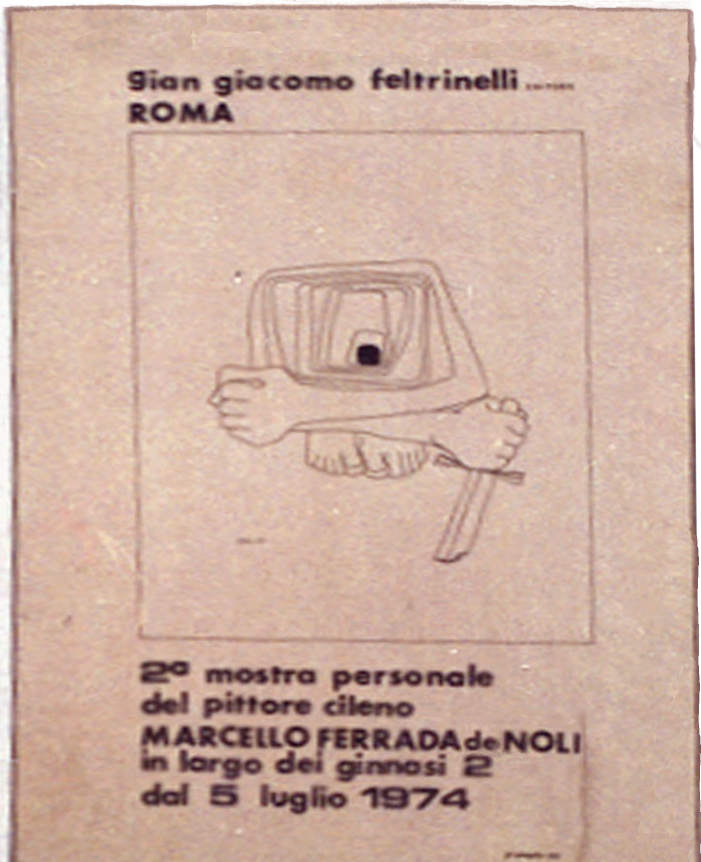
As MIR cadres were abated and our logistics became more and more precarious I have to mover more and more often between safe houses. MIR transports were in a moment extremely scarce or too risky to use, and I had finally to rely in my family for such transports. “Safe houses” were at the end just places of people around your private life, acquaintances without political bounds, or places dangerous per se. This was the case of the last safe house I could count with, in the northern sector of Concepción, and actually belonging to the maid employed at my parents’ residence. What I did not know it was she had a relationship with a sergeant of the Regiment Chacabuco. I call my father immediately to come and pick me up but the car was detained “for driving after the curfew”. I never knew if it was a set up. My family is indeed right-wing and many were, and in later generations still are, officers in the armed forces or in the Navy. On the other hand this fact contributed that I am still alive.
I was taken first to the Stadium in Concepción. The morning after I was lined with two other prisoners waiting execution – right under the goal frame – by firing squad. One of the fellow prisoners was the former executive director of the state-owned SOCOAGRO in Chillán, and the other was a 16 years old worker from a “cantera” (sort of stone mine) caught with explosives apparently taken from the mine. I was recognised by a petty officer years before serving under my father’s command. I was saved, and it was not going to be the last time. See more details in the text below (Part II) of Anna-Leena Jarva, based on my testimony and other documents.
Epilogue
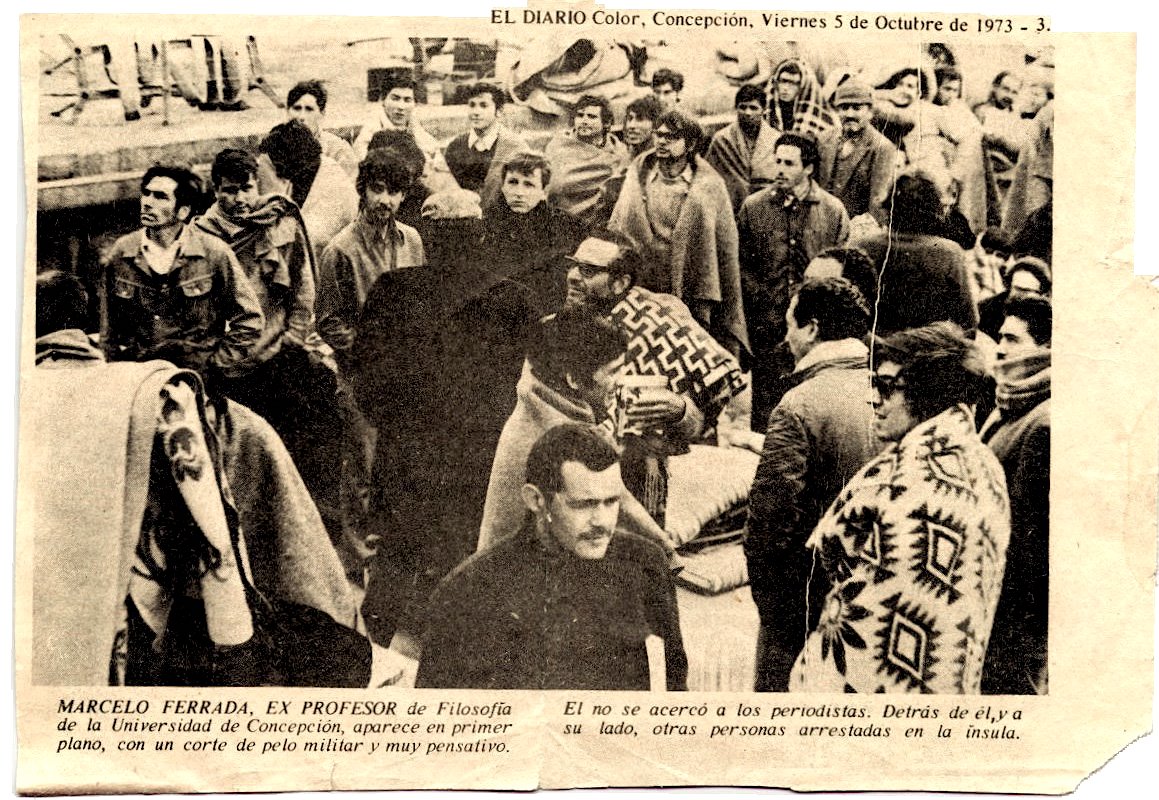
Above, image from the newspaper “El Diario Color” of Talcahuano, 5 Oct 1073. Caption in the photo reads:
“Marcello Ferrada, ex-profesor of philosphy at Concepción University, depicted in the foreground of the photo, with a military hair-cut and very thoughtful. He did not approach the journalists. Behind him, and at his side, other people arrested in the Island”. (Click to enlarge).
Editor’s Note: This image appeared in the above mentioned Lotta Continua series “Ferrada de Noli VS. Pinochet“. Under the translation of the image caption, the series’ author (Marcello Ferrada de Noli), specified the following:
“Note: The image above (marcello-ferrada-de-noli-as-pinochet-prisoner-1973) is a photography I shot in 1974 directly from a physical newspaper issue of “El Diario Color”, published 5 October 1973 (page 3). The quotidian, which was published in Talcahuano, is defunct since nearly a half century, according to Wikileaks article Medios de comunicación en Concepción. The issue was given to me by my beloved father after my release from Quiriquina Island. I edited it later on, leaving the caption text and the date. Hereby I give permission for any one to reproduce this image. Besides, to the best of my knowledge as former law student at the University of Concepción, by those times it did not exist in Chile any legal prohibition to reproduce/edit unsigned newspapers’ images –thus considered in the public domain. As the copyright holder of this work, I hereby publish it under the license Creative Commons Attribution-Share Alike 4.0 International. From my part, any other person or publisher may reproduce this image as if were the owner of the copyright.”
In the aftermath of the defeat against the military forces the days after the coup, thousands among combatants, or unarmed civilians, or left politicians & officials in the Allende government were executed or imprisoned. Some died in detention-centers or prisoners camps as consequences of torture. See PART III. My life as Pinochet’s prisoner in Quiriquina Island.
I was then 30 years old and a professor at the University of Concepción. Having worked previously as invited professor in Mexico with books published there, etc., I was released from captivity partly after direct demands from Mexican academic scholars and authorities (pressures and solidarity came also from colleagues in Italy and Germany), and partly after demands from my family which had strong tradition among the military. I was not set free in Chile but expelled from the country directly to Mexico from the prison, escorted to the airport by the military.
I had to sign in the airport a document committing me of not to speak about the atrocities in Quiriquina Island etc. However, I changed route in Lima (the first stopover in my way to Mexico), from where on instructions of my organization I went directly to Rome, Italy, in order to participate in the Russell Tribunal which had started in Rome on the crimes of Pinochet’s junta. I was main witness at the Russell Tribunal and thereafter member of the scientific committee of the Russell Tribunal together with writer Gabriel García Márquez, Linda Bimbi, and Senator Lelio Basso. Thereafter I was sent to Sweden where my last assignment from MIR’s Comité Exterior was to organize intelligence work for the counterattack to Pinochet liquidation squads in Northern Europe, activity which I lead until 1977. I resigned all my activities in MIR in June 1977, during the MIR Conference in Stockholm.
Editor of this issue: Dr. Lena Oske, MD, Acting Editor at The Indicter Magazine
__
On the author
 Professor Emeritus, med dr Anders Romelsjö (Karolinska Institutet) is Vice Chairman of Swedish Doctors for Human Rights – SWEDHR, and Member of the Editorial Board of The Indicter Magazine.
Professor Emeritus, med dr Anders Romelsjö (Karolinska Institutet) is Vice Chairman of Swedish Doctors for Human Rights – SWEDHR, and Member of the Editorial Board of The Indicter Magazine.
Prof. Romelsjö is also the publisher of a top ranked Swedish political blog, Jinge.se, and also author of numerous debate articles in main Swedish media, such as DN debatt and other newspapers.
He is also in the editorial committee of FIB-Kulturfront.
Anders Romelsjö is co-author of the book (Swedish) USA som världspolis [“USA as World’s Police”].

